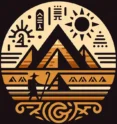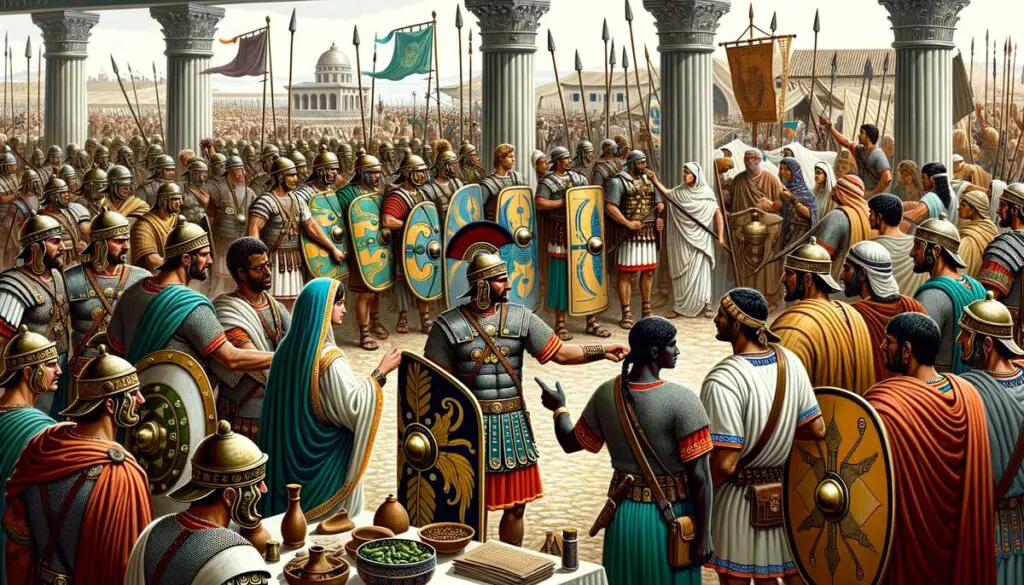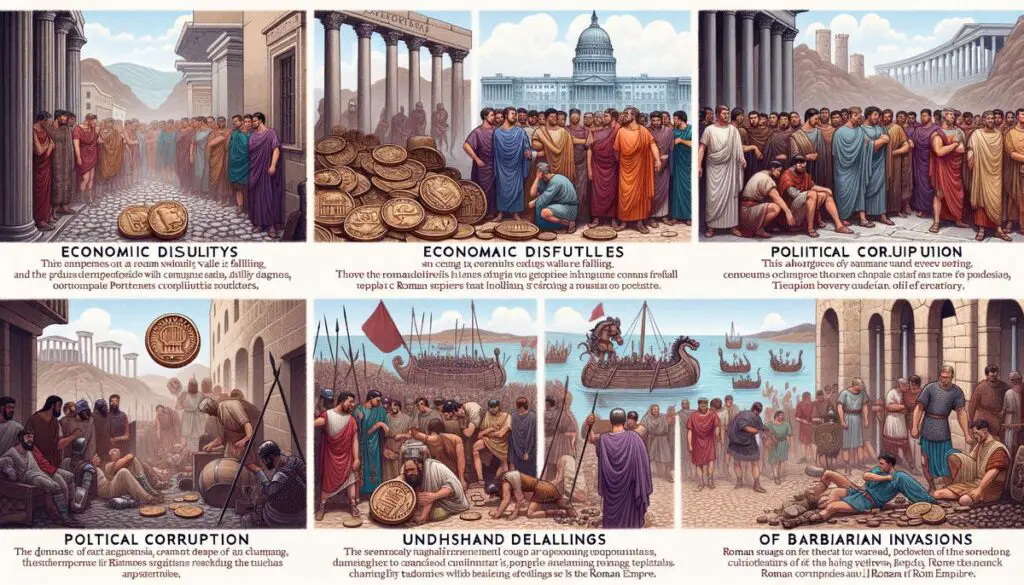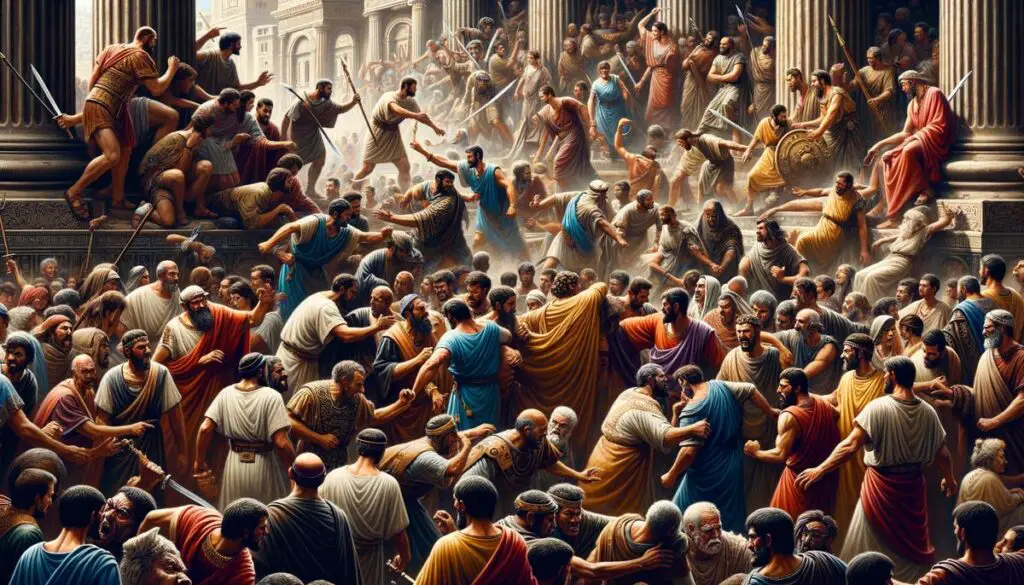The Roman Empire, an ancient civilization of great might and influence, created a lasting legacy through its complex systems of military, culture, and governance. This article aims to explore the multifaceted aspects that contributed to both the rise and fall of this mighty empire, examining the strategic advancements and challenges that defined its centuries-long dominion. From the disciplined legions that expanded its territories to the innovative political strategies that integrated diverse cultures, the story of the Roman Empire is a testament to the power of adaptation and resilience.
The Rise of the Roman Empire
The Roman Empire, a colossal entity in ancient history, stands as a testament to the power of strategic governance, military might, and cultural assimilation. This empire didn’t rise to unparalleled power overnight; it was a gradual ascent marked by calculated moves, pivotal battles, and an inclusive approach to conquered peoples.
Rome began as a small city-state around the 8th century BC, but its ambitions were anything but small. The seeds of empire were sown early, with the Romans placing a significant emphasis on the strength and discipline of their legions. The Roman military was a formidable force, known for its rigorous training, innovative tactics, and the ability to adapt and use the best practices of its adversaries. These attributes were instrumental in Rome’s victories against powerful enemies like the Carthaginians in the Punic Wars. The destruction of Carthage in 146 BC marked a turning point, leaving Rome unchallenged in the Western Mediterranean.
However, Rome’s expansion wasn’t solely through brute force. The empire’s ascent also relied heavily on its political acumen and a unique approach to governance. After annexing new territories, Rome would often offer citizenship to the inhabitants of these regions, a move that fostered loyalty towards the empire. This inclusive policy helped to integrate diverse peoples into the Roman system, creating a sense of unity and shared identity among the empire’s subjects.
Moreover, Rome understood the importance of infrastructure and logistics like no other. The construction of roads, bridges, and aqueducts not only facilitated the movement of troops and goods but also helped knit the vast empire together. This network allowed Rome to exercise control over its territories and ensured the efficient administration of the empire.
Additionally, Rome’s legal system contributed to its stability and cohesion. The codification of laws in the Twelve Tables and subsequent legal texts provided a uniform legal framework that applied to citizens and conquered peoples alike. This legal system helped maintain order and provided a mechanism for resolving disputes, which was crucial for the governance of such a vast empire.
Culturally, Rome was a melting pot, absorbing and integrating various aspects of the cultures within its domain. This cultural assimilation helped in softening the edges of conquest and in fostering a Roman identity that transcended local affiliations. The spread of the Latin language as the lingua franca of the empire further cemented Rome’s cultural and administrative hold over its territories.
In conclusion, the Roman Empire’s ascent to unparalleled power was the result of a multifaceted strategy that combined military prowess, diplomatic governance, legal uniformity, and cultural integration. This blend of strength and pragmatism ensured Rome’s dominance over the Mediterranean world and left a legacy that continues to influence modern governance, law, and civilization.
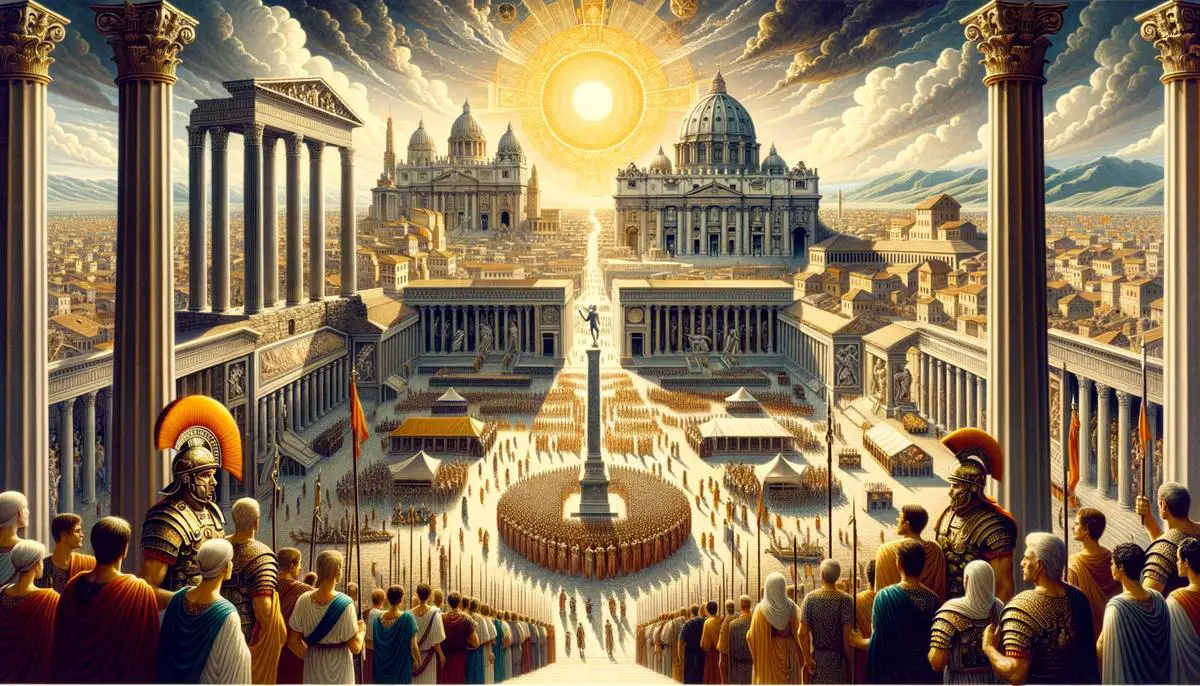
Society and Culture in the Roman Empire
In exploring the rich tapestry of Roman Empire society and culture, one cannot overlook the significance of Roman religion and mythology. Deeply interwoven into the daily lives of Romans, their religious practices were pivotal in guiding both public and private undertakings. The Romans worshipped a pantheon of gods and goddesses, led by Jupiter, the king of the gods, and included figures such as Mars, Venus, and Minerva, who were believed to influence everything from harvests to battles. Public officials even performed various rituals to earn the favor of these deities, highlighting the role of religion in governance and societal stability.
Another cornerstone of Roman culture was its architectural and engineering marvels. The Romans are renowned for their advances in engineering, which allowed them to construct enduring monuments and buildings that still capture our imagination today. The Colosseum, aqueducts, and the sprawling network of roads not only served practical functions but also stood as testaments to the empire’s grandeur and technological prowess. These structures facilitated the integration of the empire, ensuring efficient communication and the movement of troops and trade goods across vast distances.
Education and philosophy also held places of importance in Roman society. Rooted initially in Greek traditions, Roman education system aimed to produce citizens well-versed in rhetoric, philosophy, and literature. The influence of Greek thought was evident in the works of Roman philosophers like Seneca and Marcus Aurelius, whose Stoic writings emphasized virtues such as wisdom, courage, and justice. Such educational pursuits were not merely academic; they were considered essential for those seeking public office and for the general moral and intellectual development of individuals.
Entertainment and leisure activities played a pivotal role in Roman daily life, serving as a means to appease the populous and prevent unrest in the sprawling empire. The Circus Maximus and the Colosseum hosted chariot races, gladiatorial contests, and public spectacles that entertained thousands of Romans, demonstrating the empire’s capacity to organize and stage large-scale events. These gatherings were not only for amusement but also served as opportunities for emperors to demonstrate their generosity and connect with citizens of all classes.
The importance of family and societal roles within the Roman Empire further exemplified the empire’s complex societal structure. The Roman family (familia) was the basic social unit and included not just the immediate family but also slaves and domestic workers. The paterfamilias, or family head, exercised considerable authority over family members, embodying the Roman values of discipline and respect for authority. Women, while subject to the paterfamilias’ authority, could gain influence and respect within the household and, in certain periods, enjoyed rights to own property and conduct business.
Lastly, Rome’s economy, underpinned by agriculture, trade, and slavery, was a vital component of its society and culture. The vast agricultural estates (latifundia) underscored the wealth and power disparities between the elite and the lower classes. Slavery was an integral part of the economy, with slaves performing various roles from household servants to laborers in mines and farms. Trade networks extended across the empire and beyond, bringing goods such as spices, silk, and precious stones to Rome and distributing Roman wine, olive oil, and pottery across Europe, Africa, and Asia.
In sum, the Roman Empire’s society and culture were characterized by a rich blend of religious practices, architectural and technological achievements, educational pursuits, and social structures. These elements, combined with the empire’s military and political strategies, formed the backbone of Roman civilization, leaving a legacy that continues to fascinate and influence the modern world.
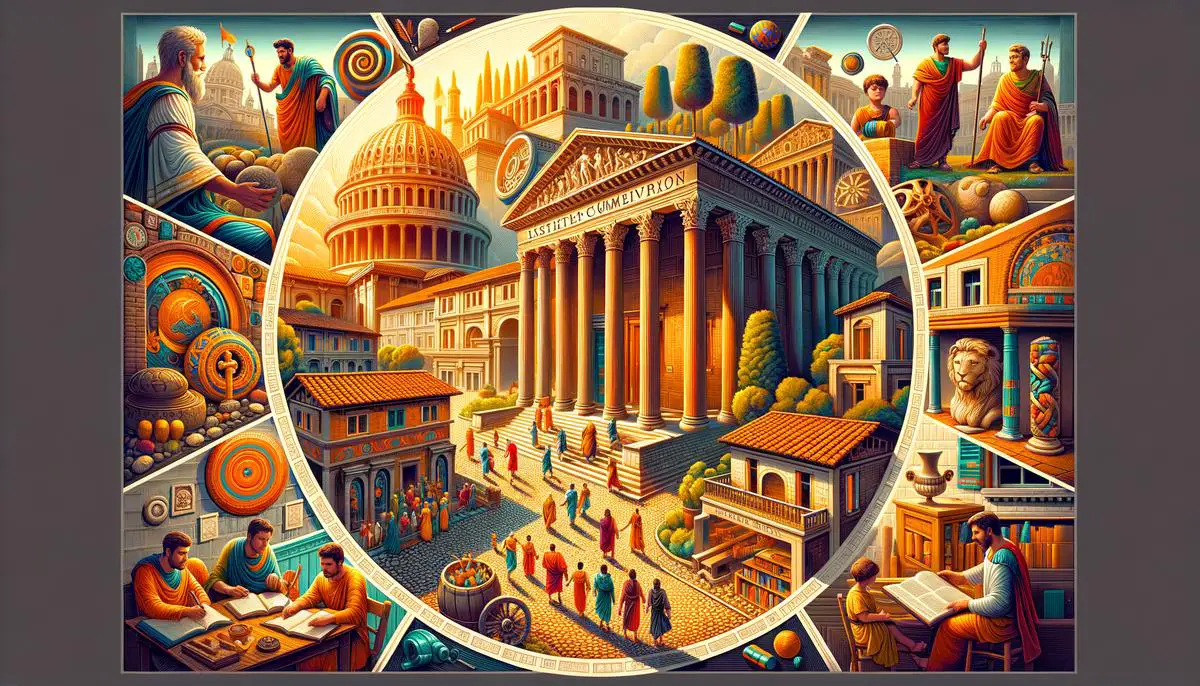
The Economy of the Roman Empire
The Roman Empire, a civilization renowned for its military prowess and political strategy, also boasted an incredibly sophisticated economy that played a pivotal role in its rise to greatness and, eventually, its decline. At the heart of this economy was a complex system of trade, fueled by Rome’s vast network of roads and the Mediterranean Sea, which acted as a conduit for commerce. This infrastructure facilitated the movement of a diverse array of goods, from the grain that fed Rome’s legions to the luxuries that adorned its wealthier citizens’ lives.
Agriculture formed the backbone of the Roman economy, with vast estates (latifundia) dominating much of the countryside. These estates, worked by slaves captured in Rome’s numerous military campaigns, produced olives, grapes, and grains. Slavery, thus, became an essential component of the economic model, enabling the production of goods at minimal cost, which, in turn, supported the empire’s urban population and military.
Trade routes extended beyond the empire’s borders, bringing in resources such as silk from China and spices from India, demonstrating Rome’s connectivity with the wider ancient world. The implementation of a standardized currency across the empire facilitated trade, helping to stabilize the economy and allowing for the collection of taxes, which funded military expeditions and public works.
However, the strengths of the Roman economy also sowed the seeds of its vulnerability. The reliance on slave labor discouraged technological innovation, as the cheap and abundant labor force rendered economic incentives for efficiency through machinery or methods unnecessary. This lack of innovation would become a critical factor as the empire faced increasing external pressures.
Economic disparity and wealth distribution became more pronounced over time, with a small elite accumulating vast wealth while a significant portion of the population lived in poverty. This inequality contributed to social unrest and made it difficult for the empire to mobilize resources in times of crisis.
Moreover, Rome’s expanding borders became increasingly difficult to defend, straining the empire’s resources. The costs of maintaining the military, coupled with diminishing returns from conquered territories, gradually eroded the empire’s economic base. The devaluation of currency through coinage debasement, a desperate attempt to meet military expenses, led to rampant inflation and further economic instability.
The invasion of the Roman Empire by various barbarian tribes during the 5th century AD, which culminated in the sack of Rome, was not just a military defeat but also an economic catastrophe. The disruption of trade networks and the destruction of infrastructure plunged the western part of the empire into economic turmoil, highlighting the fragility of Rome’s economic foundation.
In conclusion, the Roman Empire’s economy was a complex and multifaceted system that contributed significantly to its centuries-long dominion over the Mediterranean. It facilitated unprecedented levels of prosperity and socio-political cohesion. However, inherent flaws in its economic structure, such as over-reliance on slave labor, economic inequality, and the unsustainable costs of military expansion, ultimately contributed to its downfall. As we reflect on the history of the Roman Empire, the intricate relationship between economic stability and the endurance of a civilization becomes evident, offering valuable lessons for the modern world.
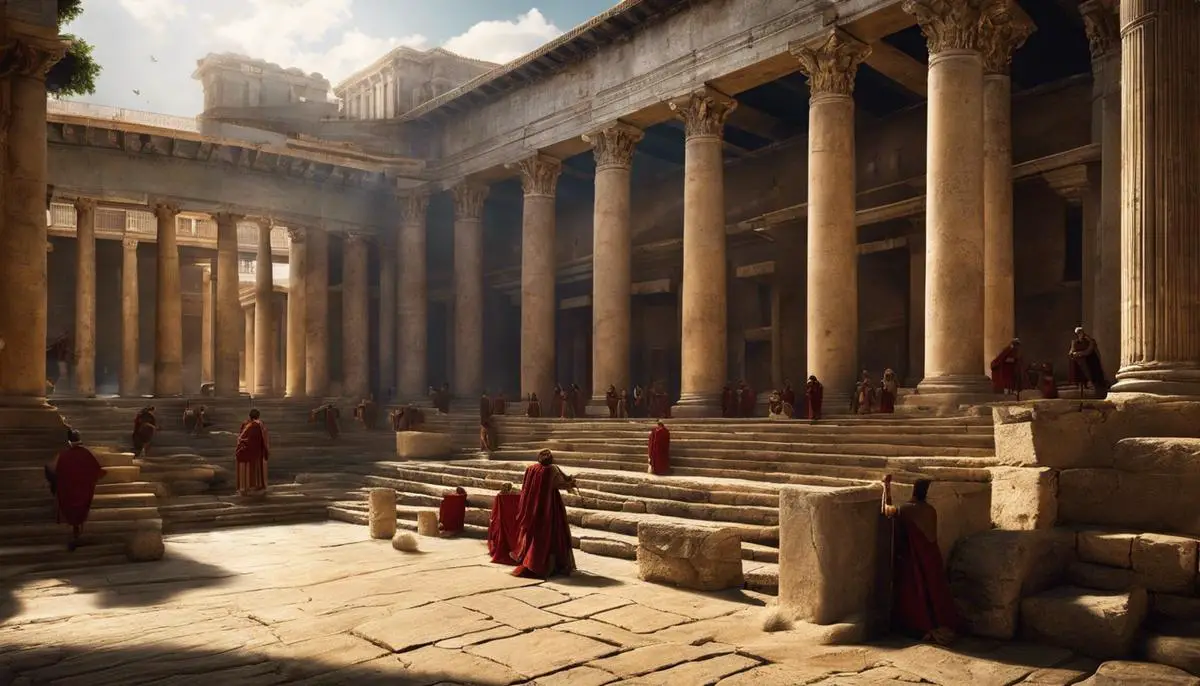
The Fall of the Roman Empire
Leaning into the heart of the Roman Empire’s downfall requires us to unravel a complex web of internal discord and external pressures. While the glory of Rome was built on the backs of its legions, infrastructure, and governance, its decline was equally multifaceted, involving shifts in military practices, leadership crises, and the empire’s sprawling geography.
- One of the pivotal factors ushering in Rome’s decline was the gradual erosion of military discipline and might. Over time, the Roman legions, once the epitome of discipline and effectiveness, started to fray at the edges. The recruitment of non-Roman soldiers diluted the legions’ loyalty to Rome. These mercenaries fought not for the glory of Rome but for pay, leading to diminished cohesion and reliability. Additionally, as the borders of the empire expanded, defending its vast territories became a Herculean task, stretching the military thin and exposing vulnerabilities.
- Leadership within Rome also took a dire turn. The principled governance of early Rome gave way to a series of ineffectual, and sometimes corrupt, emperors who could not effectively manage the sprawling empire or its myriad challenges. This period of political instability was marked by frequent changes in leadership, with emperors often coming to power through intrigue or outright violence, rather than merit or popular acclaim. The lack of steady and wise leadership further destabilized the empire from within.
- Environmental factors and public health crises also played a role. The empire faced several significant challenges, including famine and plagues, which decimated the population at various points. These catastrophes weakened the Roman workforce, military, and economy, contributing further to the empire’s struggles.
- Additionally, Rome’s vast geography became a double-edged sword. While the extensive roads and infrastructure facilitated trade and military movement, they also exposed the empire to invasions. The increasing pressure from barbarian groups at the empire’s borders was relentless. Groups such as the Goths, Vandals, and Huns capitalized on Rome’s weaknesses, pushing into its territories with increasing success. The sack of Rome by the Visigoths in 410 A.D. was a shocking breach of what was once considered invincible Roman might.
- The division of the Roman Empire into the Eastern and Western empires under Diocletian was intended to ease governance and defense. However, it also sowed the seeds of division. The wealthier and more stable East, later known as the Byzantine Empire, increasingly distanced itself from the beleaguered West. This fragmentation weakened the West further, making it more vulnerable to external pressures and internal decay.
- Ultimately, the fall of the Roman Empire was not the result of a single event but a cascade of erosions within its military, leadership, social fabric, and economic stability. The sack of Rome by the Odoacer in 476 A.D. is traditionally marked as the end of the Western Roman Empire, symbolizing a profound shift from the ancient world to the dawn of the Middle Ages in Europe. Rome’s legacy, however, its language, laws, and cultural contributions, would live on, shaping the foundation of Western civilization.
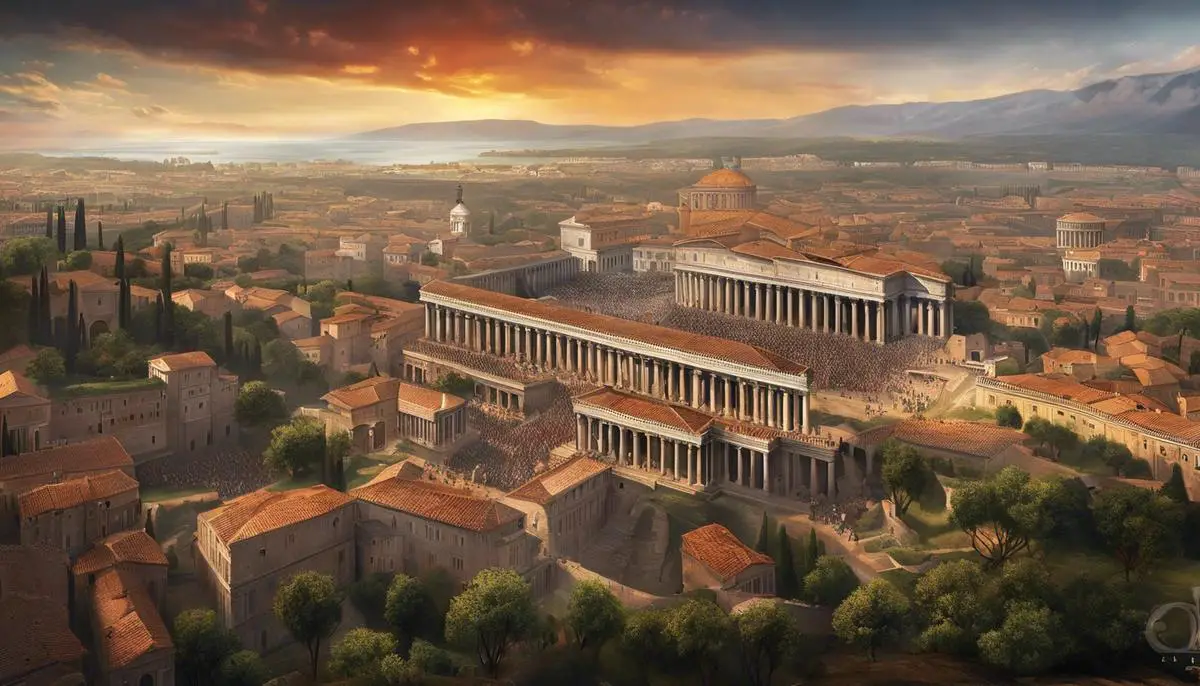
Through examining the intricate tapestry of the Roman Empire’s society, culture, economy, and military prowess, we gain invaluable insights into the factors that contributed to its unprecedented rise and eventual downfall. The legacy of Rome, with its profound contributions to law, language, and governance, continues to resonate through time, reminding us of the enduring impact of this ancient civilization. As we reflect on the Roman Empire, we are reminded of the complexity of managing such a vast and diverse entity, the challenges of sustaining economic and military strength, and the timeless nature of human ambition and resilience.
- Julius Caesar Adaptations - April 15, 2024
- Declaration of Independence - April 15, 2024
- US Civil War Analysis - April 14, 2024
